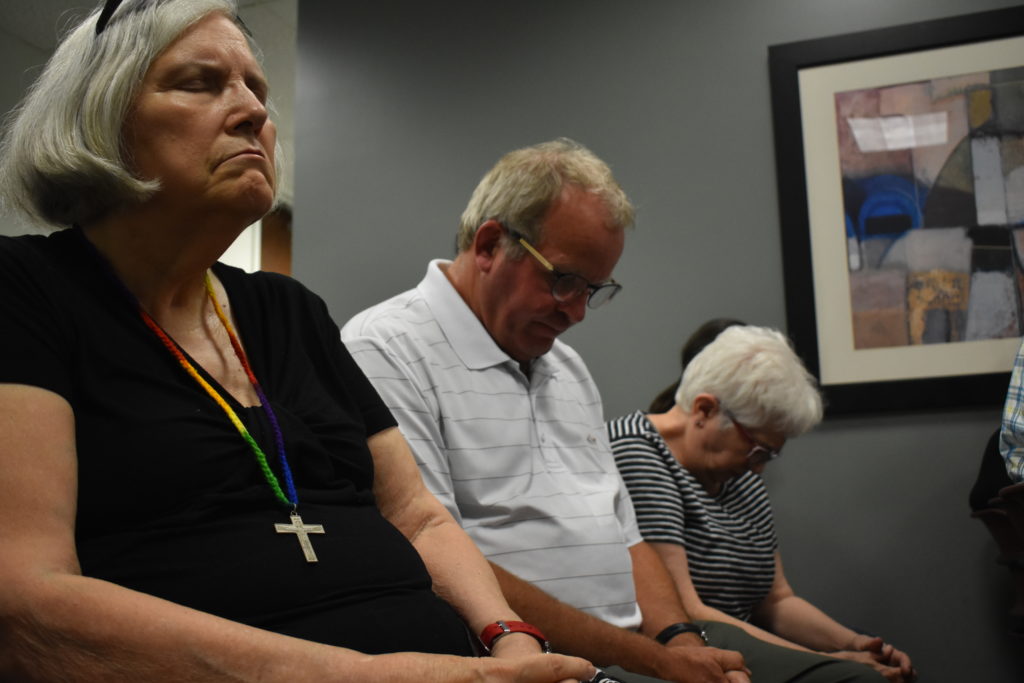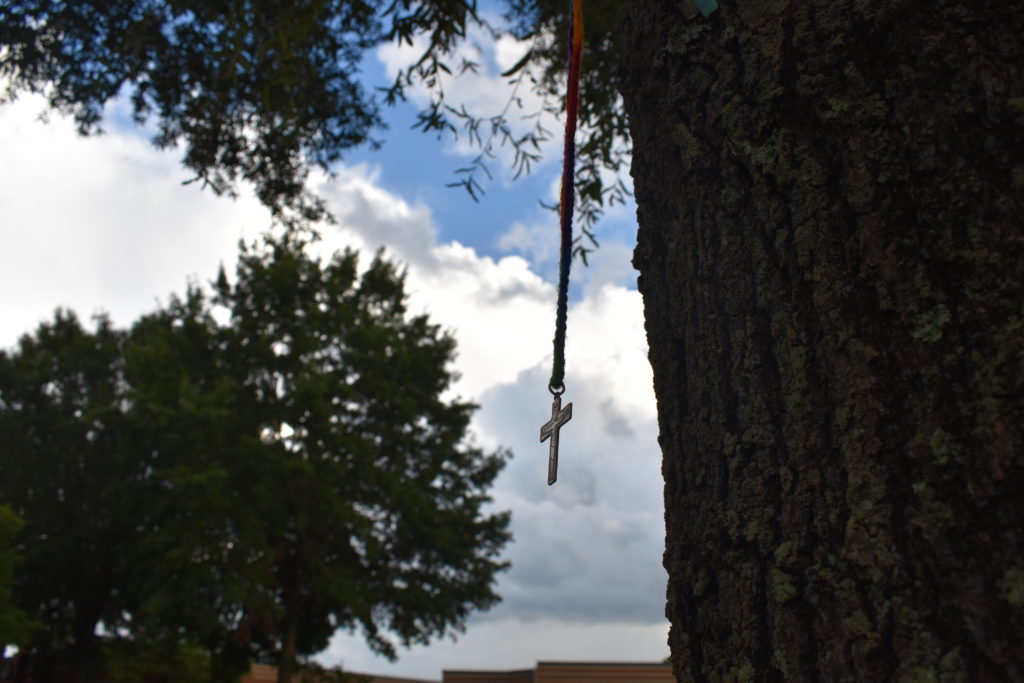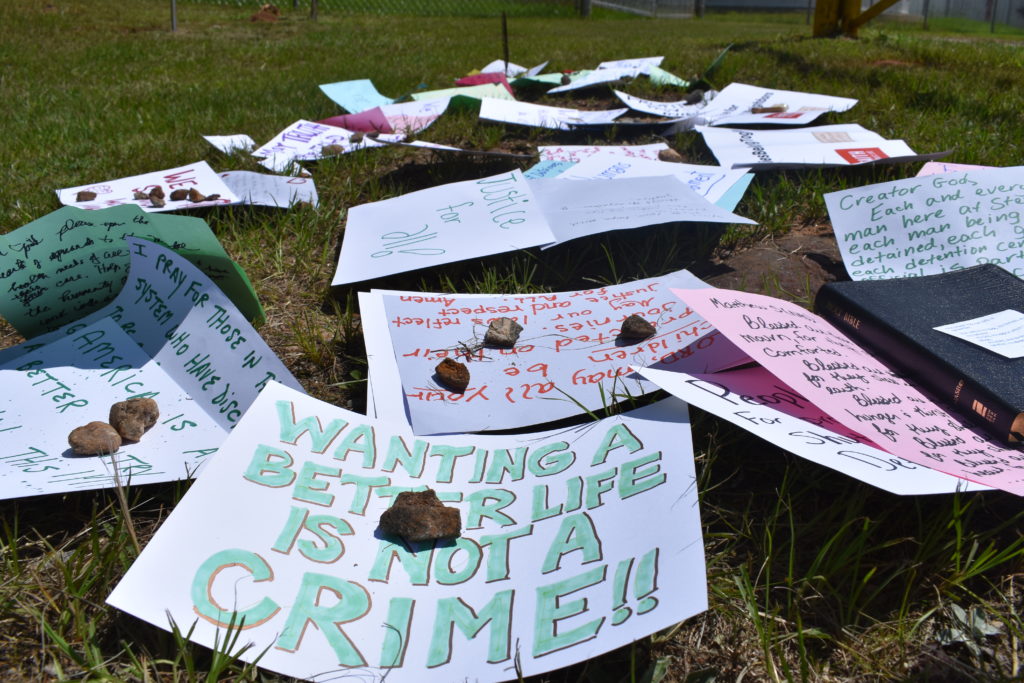Although I’m a fourth-generation Mexican-American who grew up in Texas, I was in my 20s before I was introduced to life in the “New Latino South” following a move to Atlanta 10 years ago. Coworkers would ask me why so many people from Latin America were moving into their neighborhoods and starting to visit their churches. I did not know what to tell them. Although I was Latina, my experiences in Texas were not the same as this new clash of cultures. After all, Texas was once part of Mexico, and the two cultures have remained deeply intertwined.
I did not stay in Atlanta long. While my job in Atlanta was fulfilling, the social context, micro-aggressions, and conversations were overwhelming.
A decade later, however, I returned to participate in a pilgrimage with Myers Park Baptist Church in Charlotte, North Carolina, joining senior pastor Benjamin Boswell, associate minister Christy Tatum Williamson and about two dozen members. I was intrigued and curious to see what might have changed in the New Latino South, particularly as our nation struggles with the immigration crisis of the undocumented and detained.

Participants of the Awakening to Immigration Justice Pilgrimage with Myers Park Baptist Church gather for orientation and prayer before their journey begins. Photo/Mackenzie Harris
We gathered in August on a rainy, hot day in Charlotte. Nearly 20 people arrived early in the morning at Myers Park (MPBC) to embark on this sacred pilgrimage to listen, learn and discern how God is calling them as individuals and us as a Church to seek justice for America’s immigrants. A pilgrimage is a physical journey with a spiritual purpose. Pilgrim travelers prepare, set intentions and enter a journey in a spirit of prayer and awareness. These pilgrims had prepared with a year-long study at MPBC titled “Awakening to Immigrant Justice.” The culmination of the study helped open their eyes to the complex, convoluted and, in many cases, inhumane ways newcomers are treated in this country. They set their intentions to follow the path of an immigrant detained by the U.S. Department of Homeland Security Immigration and Customs Enforcement (ICE) and to bear witness to the truth of the humanitarian crisis affecting our immigrant brothers and sisters as a result of the policy changes to the U.S. immigration system.
“These pilgrims had prepared with a year-long study at MPBC titled ‘Awakening to Immigrant Justice.’ The culmination of the study helped open their eyes to the complex, convoluted and, in many cases, inhumane ways newcomers are treated in this country.”
Myers Park partnered with several organizations to follow the path of many undocumented immigrants: Faith in Public Life, El Refugio, Cooperative Baptist Fellowship, Atlanta Sanctuary Movement and First Baptist Church of Decatur, Georgia. The itinerary for a journey of fewer than 48 hours was demanding. It began with prayers and an orientation at MPBC, followed by a prayer vigil outside the Charlotte Immigration Court and a drive to York County Detention Center, a Georgia facility that houses immigrants awaiting deportation.
Throughout our journey, the group strived to discern next steps for themselves and their church.
“By placing our feet on sacred grounds which are off our well-beaten paths, we hope to expand our listening and learning,” Boswell explained. “Moving beyond head to heart, beyond words to feelings, we yearn to gain a fuller understanding of our systems of immigration.”

Participants of the Awakening to Immigration Justice Pilgrimage with Myers Park Baptist Church pray at the Charlotte Immigration Court. Photo/Mackenzie Harris
Before embarking, participants discussed their intentions and shared their concerns:
“What does Jesus actually want us to be doing?”
“As an ESL teacher, I want a different perspective because I hear these stories from the periphery.”
“I’m worried how to communicate to people once I return.”
“I want a perspective and deeper understanding of the system.”
“I hope to learn more about the plight of immigration to this country.”
After the orientation, the group boarded a pair of white buses. At the first stop at the Immigration Court, Cynthia Aziz, an immigration attorney, described challenges facing immigrants in the Charlotte area. Until 8 or 9 years ago, she had to travel to Atlanta for her clients’ hearings on immigration cases. Today, the four immigration judges in Charlotte appointed by the U.S. attorney general hear nearly 8,000 cases a year. According to Aziz, the Charlotte court has earned a reputation as one of the toughest in which to win an asylum case. It’s one of the courts with the highest rate of deportation orders. The Transactional Records Access Clearinghouse (TRAC) estimates that the Charlotte Immigration Court will hit a 10-year high with almost 5,000 deportations in 2018. Through May, 293 deportees were children.
To be granted asylum in the United States, immigrants must prove that they fear persecution based on race, religion, nationality or politics. Unlike criminal courts, there is no right to government-paid counsel because immigration court cases are civil proceedings. Yet, the chances to obtain asylum rely heavily on the ability to afford a lawyer which typically costs $5,000 or more. Furthermore, said Aziz, the process is intimidating for most immigrants because they are unfamiliar with the American legal system.
“The pilgrimage also reminded me not to be silent, to heed the chorus of the freedom song, ‘We won’t be silent anymore.’”
The group followed the route many undocumented immigrants in North Carolina must follow after being detained. They are transported from immigration court in Charlotte to Stewart Detention Center in Lumpkin, Georgia. We met with persons involved in the sanctuary movement and with CBF leaders who were on the southern border during the child separation humanitarian crisis and are now advocating for immigration reform. In Lumpkin, we joined other faith leaders to form a “prayer chain” around the detention center to call for justice and to denounce shameful immigration policies that criminalize children and families seeking safety.
The pilgrimage travelers talked with Amilcar Valencia, the sole employee of El Refugio, a ministry of hospitality – the only one of its kind – in Lumpkin. Valencia meets regularly with immigrant detainees and coordinates visits with the men who call Stewart their temporary home. The group also listened to advocates for immigration justice who are working with and for immigrants every day.

Prayers, songs, meditation and expressions of support were shared outside the Stewart Detention Center on the Awakening to Immigration Justice Pilgrimage with Myers Park Baptist Church. Photo/Mackenzie Harris
As the group continued on the journey, we entered into a time of liturgical worship. Someone would read or tell what they knew about the upcoming stop, which was often followed by questions and answers. There were also moments of pacing as if to take in our surroundings, followed by a group prayer, singing and then silence again to take it all in.
Somebody’s hurting my brother and it’s gone on
far too long
and we won’t be silent anymore!
Somebody’s hurting my sister and it’s gone on
far too long
and we won’t be silent anymore!
Somebody’s deporting our neighbors and it’s gone on
far too long
and we won’t be silent anymore!
Somebody’s separating children and it’s gone on
far too long
and we won’t be silent anymore!

Photo/Mackenzie Harris
At each of the stops on the pilgrimage, participant Jane Offill left behind one of the cross relics she had purchased on a trip to Latin America. She wanted them to be tangible reminders that the immigrants are not forgotten and that someone is praying for them.
When we arrived at Stewart Detention Center, participant Carol Pearsall met the wife and daughter of Jose, an undocumented immigrant who had been arrested three days earlier during a routine police traffic stop. Jose’s daughter hugged Pearsall and started crying. Pearsall listened to her story and prayed with her.
Three weeks after the pilgrimage, Pearsall was still thinking of that encounter. “I’m still on a quest to find out about Jose’s situation at Stewart Prison,” she said. “I find it frustrating that info on prisoners is not public knowledge or easy to find.”
For Pearsall and the other pilgrims, there have been more questions than answers. Why was Jose arrested and scheduled for deportation? Why are these immigrants put in a position where they cannot be defended? Where are the public defenders?
Stewart Detention Center is a private prison with nearly 2,000 beds. Operated by the Corrections Corporation of America, the center is located about 150 miles south of Atlanta. It is considered one of the most remote detention centers in the country. A portion of the money paid for each inmate is also paid to the county. The center’s remote location almost guarantees that asylum seekers will have no legal representation and that Stewart will continue to board one of the highest deportation rates in the country.
“As I reflect on all of the moments where the mistreatment of unfortunate people was so obvious, it broke my heart to see how these people must feel so much pain.”
Along the bus rides, one of the topics of discussion was immigration in Charlotte and some of the changes that have occurred over the years. Although not all of the changes have been positive, everyone was glad that the 287(g) program recently came to an end. According to ICE’s website, “The Illegal Immigration Reform and Immigrant Responsibility Act of 1996 added Section 287(g), performance of immigration officer functions by state officers and employees, to the Immigration and Nationality Act. This authorizes the Director of ICE to enter into agreements with state and local law enforcement agencies, permitting designated officers to perform immigration law enforcement functions, provided that the local law enforcement officers receive appropriate training and function under the supervision of ICE officers.”
The former sheriff of Mecklenburg County participated in the 287(g) agreement with ICE. However, in May, Gary McFadden was elected and did not renew the county’s participation. ICE has 287(g) agreements with 78 law enforcement agencies in 20 states, including the North Carolina Department of Corrections and York County Sheriff’s Office. (To learn if your city is a part of the 287(g) program, visit https://www.ice.gov/287g.)

“Wanting for a better life is not a crime!” Signs and notes of support were left outside the Stewart Detention Center on the Awakening to Immigration Justice Pilgrimage with Myers Park Baptist Church. Photo/Mackenzie Harris
Participant Tara Harris reflected on the pilgrimage experience in an article on the MPBC website:
Standing on the soil there on Saturday afternoon, we prayed, sang, and listened, leaving relics (for me, a Bible, a prayer for both those being detained and those detaining, and a small sign saying “no human being is illegal”), sweating, thinking, and asking questions.
The listening meant the most to me that afternoon. A woman came out of Stewart Detention Center after visiting several detainees and told us their stories – stories of inedible and unsafe food, of inflated prices of things available to buy in the commissary, of too many men in one room with too few accommodations and bathrooms.
What all of this has inspired me to do right now is find out more. Find out more about the neglect and poor conditions that have been rampant at Stewart Detention Center. Find out more about our three neighbors/brothers who have died at Stewart in the last fifteen months. Find out more about the disparity between the number of people whose cases end in orders of “final deportation” from Stewart versus people detained or tried in other ICE detention facilities around our country (at Stewart, there’s a more than 20% higher deportation rate than the national average). Find out more about respite houses like El Refugio near detention centers like Stewart.
The pilgrimage also reminded me not to be silent, to heed the chorus of the freedom song, “We won’t be silent anymore.”
The 782-mile pilgrimage from MPBC to Stewart Detention Center and back was emotionally difficult. “As I reflect on all of the moments where the mistreatment of unfortunate people was so obvious, it broke my heart to see how these people must feel so much pain,” said Pearsall. However, the pilgrimage was also an example of how churches can gather around immigrants, documented and undocumented, in their communities through ministries like those that partnered with the church in its pilgrimage project.
In a report to the congregation, Boswell said “our pilgrims heard stories that sounded more like nightmares of how the justice system plays out for America’s immigrants. Staggering statistics and consistent tales of inhumane treatment left them all feeling that they must bear witness to what they have seen and heard.”
As we traveled back to Charlotte, I could not help but think how much the New Latino South had changed in the past 10 years. The faith community of Charlotte was gathering around immigrants, documented and undocumented, in their communities. As I reflected on conversations with others on the pilgrimage, I could not imagine a better way to return to the South. Unlike the first time I lived here, I now found myself embraced by a community that was willing to share their stories of working with immigrants in their community and their desire to learn from them.

Prayers are offered outside the York County Detention Center on the Awakening to Immigration Justice Pilgrimage with Myers Park Baptist Church. Photo/Mackenzie Harris
Read more in the Awakening to Immigrant Justice Series:
How to help immigrants in detention
Photo Gallery: Awakening to Immigration Justice
Video: Pilgrimage to Immigration Justice
Related commentary at baptistnews.com:
On the border: ‘Children of a lesser god’ | Bill Leonard
Inviolate! The protection of all children | Kathy Manis Findley
Related news at baptistnews.com:
Cooperative Baptists trek to border for prayer, advocacy outside migrant child care center
Pastor: ‘Protecting borders’ was also the excuse for detention of Japanese-Americans
Baptist ethicist says undocumented immigrants deserve more than hospitality
Myers Park Baptist Church in Charlotte, N.C. embarked on a sacred pilgrimage to listen, learn and discern how God is calling them as individuals and as a Church to seek justice for America’s immigrants. The group followed the route to Georgia many undocumented immigrants in North Carolina must follow after being detained. These pilgrims had prepared with a year-long study titled ‘Awakening to Immigrant Justice.’ The culmination of the study helped open their eyes to the complex, convoluted and, in many cases, inhumane ways newcomers are treated in this country.
This series in the “Welcoming the Stranger” project is part of the BNG Storytelling Projects Initiative. In “Welcoming the Stranger,” we share the inspiring stories of the people and faith communities that are teaching us all to love our neighbor as ourselves.
_____________
Seed money to launch our Storytelling Projects initiative and our initial series of projects has been provided through generous grants from the Christ Is Our Salvation Foundation and the Eula Mae and John Baugh Foundation. For information about underwriting opportunities for Storytelling Projects, contact David Wilkinson, BNG’s executive director and publisher, at [email protected] or 336.865.2688.


